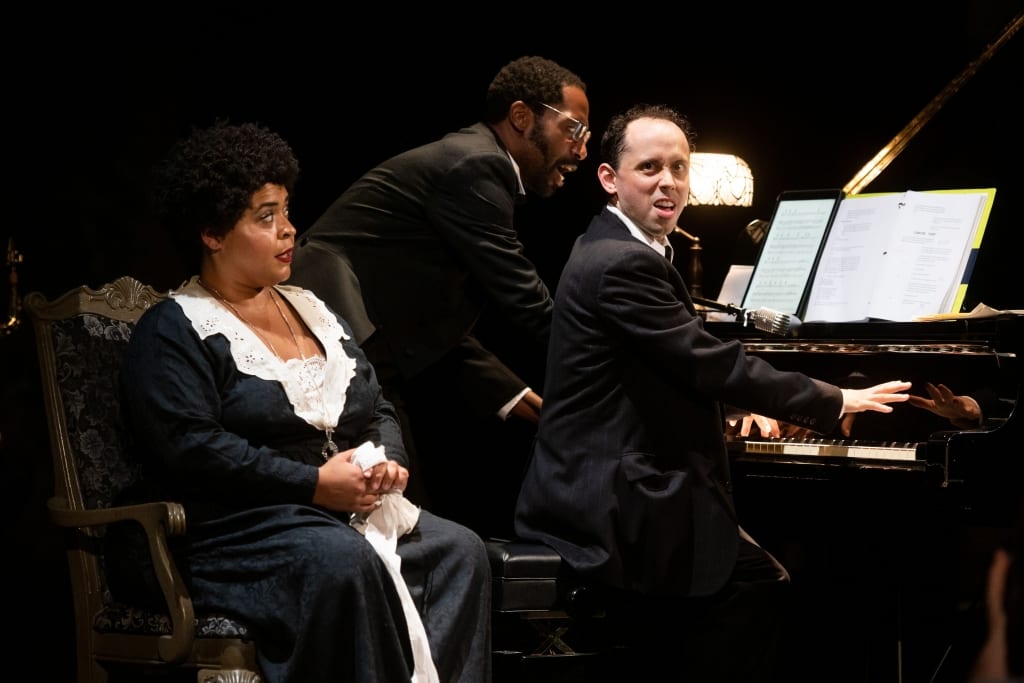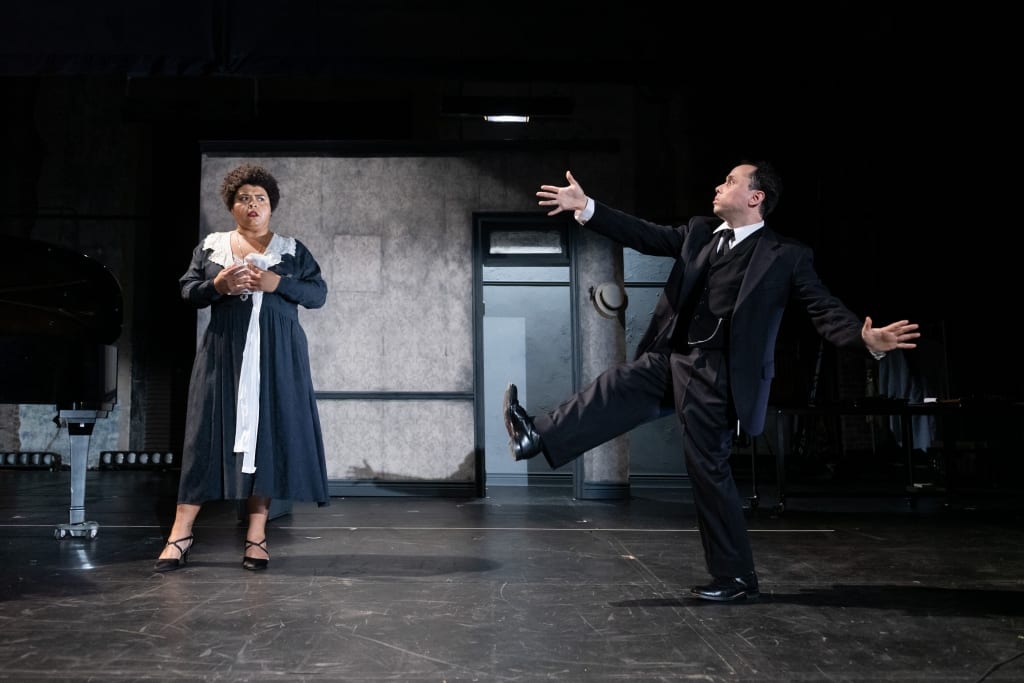Imagine time-traveling. There’s likely some point between the time period you’re coming from and the one you’re going to where you’re sort of in between, one foot in your own era and another in, say, 92 years in the past. So appears the Abrons Arts Center as it’s set up for jazz singer, a re-exploration of the famous first “talkie” and its place in modern conversations about race and belonging.
Record players are set next to a Macbook atop a table. Classic jazz music plays while a TV rolls clips and lines from the original The Jazz Singer movie to catch us younger audiences up on its plot. The chairs and piano are time-worn, yet used by actors in modern casual dress – it’s a clear product of the present day but not clearly situated in one moment in time. Then again, neither are the questions it asks. jazz singer is all about questions. There aren’t too many answers, but they’re surely bits of food for thought worth coming to chew on. The main point of contention is the original movie’s use of blackface and how to reconcile its current racist implications with its centrality to The Jazz Singer’s plot in any re-interpretation.

The Jazz Singer is about a Jewish man, Jack Robin, who forgoes his father’s wish to be a synagogue singer to sing jazz on Broadway. It builds up to a climactic scene in which the main character is applying blackface makeup when he’s told he must choose between singing at the opening of his Broadway show or at a religious service in place of his father, who has fallen ill. The application of the makeup has been analyzed as a critical symbol for Robin’s own “ethnic hybridity,” as one scholar called it: he, as a Jew, is is aligning himself with another racial “other” of the time, yet his ability to perform a minstrel act and apply the makeup also marks him as white. That’s not to say it’s not problematic, but it’s not easily omittable.
As it unpacks that situation, the first part of jazz singer also grapples with … well, itself. And of course, that movie which is older than most audience members. The creative team doubles as actors playing “composite” versions of themselves, bringing the questions that were supposedly asked of the show in the workshop room to the stage and inviting the audience to ask them too. The Jewish director (Joshua William Gelb) and black music director (Nehemiah Luckett) debate: if the plot focuses on a Jewish man yet jazz is a black creation, whose story is it? What is actually accomplished by digging up these old movies and expressing our guilt towards their problems? Why, instead of just saying, “thanks, but no,” do we have to “deal with” the blackface at all?

Again, there are no straightforward answers, but the second part is the result of the questions: the finalized reinterpretation of the movie that audiences are meant to analyze for themselves. On its surface, it’s a visually and sonically beautiful rendition. The live orchestrations (performed by Luckett on piano and rotating guest musicians on horns) combined with the staging of The Jazz Singer scenes, all overlaid with projections of either movie quotes or close-ups of the actors onstage, make a Hollywood-worthy package. There is one moment in which three of the actors sing a hymn in harmony a cappella, and it’s nothing short of breathtaking. But beneath the aesthetic veneer, you’re needled by those questions from part one. When Luckett plays the piano, you recall a discussion from part one about a Harlem screening of The Jazz Singer that was silent and accompanied thus by live black jazz musicians. You recall his struggle with performing his identity, how although he has reclaimed the jazz music of his heritage for himself now, he’s not immune from the movie’s theme of “performing blackness.” You may recall, as I did, perhaps the only clear stance jazz singer takes: the idea that Robin’s father disgustedly calling him a “jazz singer” was the equivalent of using a racial slur for black people.
And then three words are projected on the screen: “The atonement begins.” It’s an introduction to the final scene, the re-interpretation of the blackface makeup scene, but it’s also an invitation. It’s an invitation to come to your own conclusion about the effectiveness of this reinterpretation, and whatever that conclusion may be, to live with it. Or perhaps, to decide there’s no true conclusion, to say “thank you, but no,” and to leave The Jazz Singer and jazz singer in your past.

